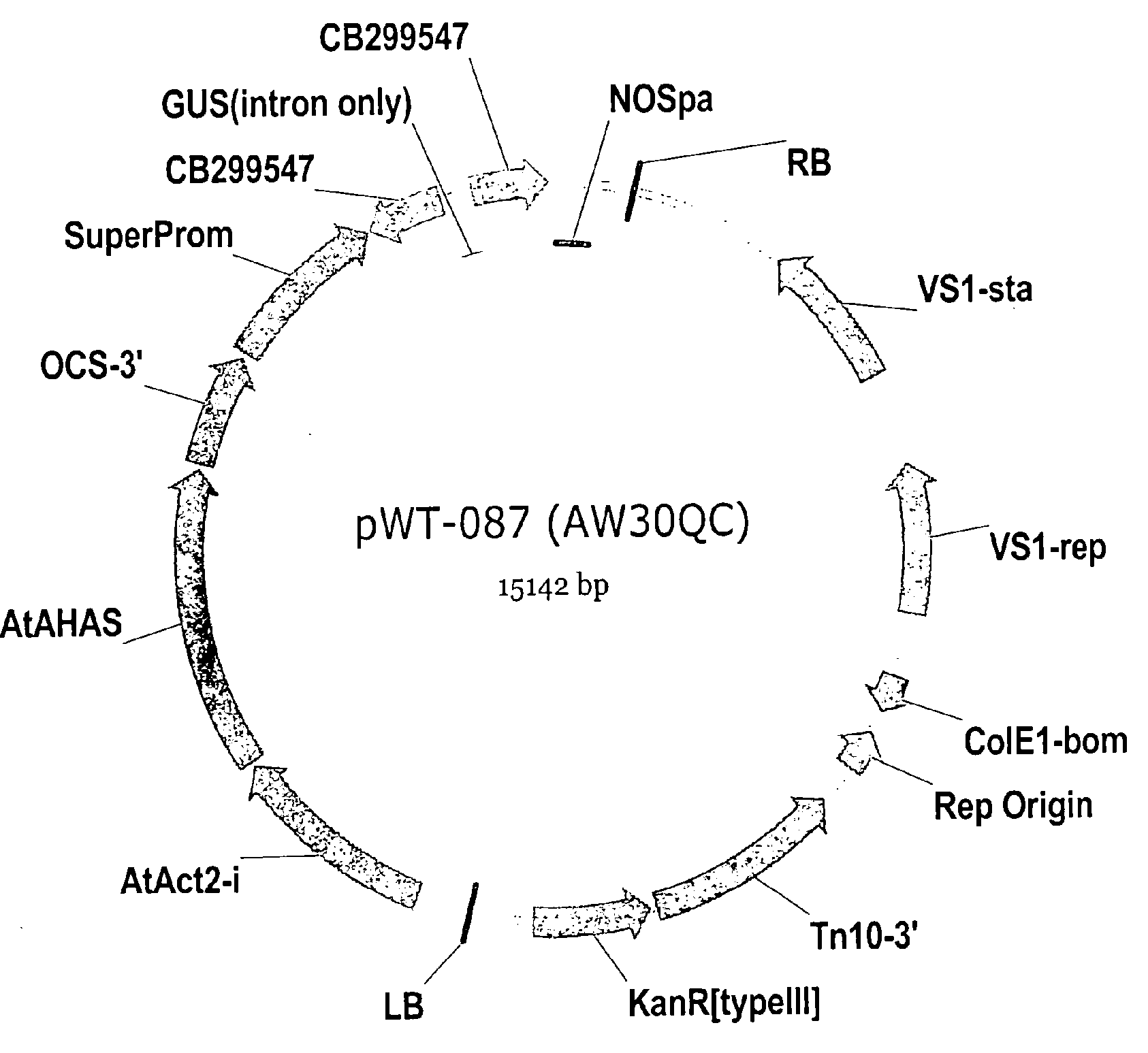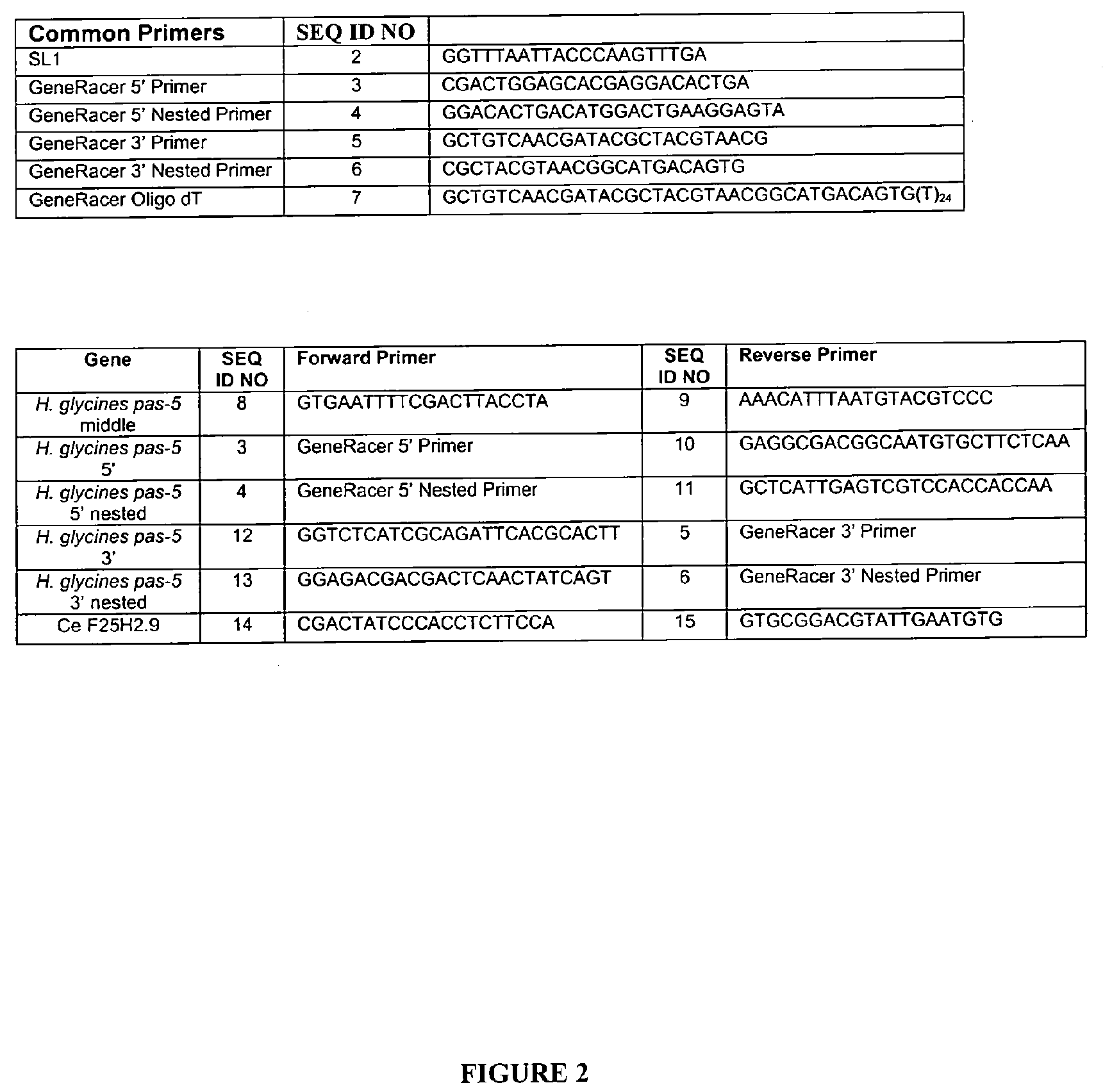Compositions and methods using RNA interference for control of nematodes
a technology of nematodes and compositions, applied in the field of nematodes control, can solve the problems of wilting of plants, soybean production is no longer economically possible without, and the estimated $100 billion crop loss worldwid
- Summary
- Abstract
- Description
- Claims
- Application Information
AI Technical Summary
Benefits of technology
Problems solved by technology
Method used
Image
Examples
example 1
Identification and Isolation of H. glycines pas-5 Target Gene
[0087] The target candidate gene was identified through intensive datamining of the GENBANK SCN EST and C. elegans databases. The criteria used for datamining include EST sequence assembling, blast searches, expression of SCN target genes in pre-parasitic J2 stages and parasitic stages, no or very low homology of SCN target genes to soybean endogenous genes at nucleotide levels, essentiality of C. elegans homologues and their suitability for RNAi by feeding. The definition of essentiality for a gene includes, for example, developmental defects, lethality and sterility when the target gene is down-regulated or knocked-out by RNAi.
[0088] Using total RNA isolated from SCN J2 stage, RT-PCR was used to isolate cDNA fragments that were approximately 400˜500 bp in length. The PCR products were cloned into TOPO pCR2.1 vector (Invitrogen, Carlsbad, Calif.) and inserts were confirmed by sequencing. RT-PCR was performed using prime...
example 2
Isolation and Demonstration of Essentiality of C. elegans Homologs of SCN Target Gene
[0093] RNAi was discovered in the free-living model nematode C. elegans (Fire et al., Nature 391: 806-811, 1998). One of the methods for introducing dsRNA into C. elegans is to feed the nematodes with bacteria expressing dsRNA, as C. elegans uses bacteria as its food sources (Timmons and Fire, Nature 395, 854, 1998). This method is also analogous to the delivery of dsRNA into SCN through feeding cells, the nutrient sources for SCN provided by plant host.
[0094] The homolog of the SCN target gene identified in Example 1 was isolated from C. elegans using PCR primers (SEQ ID NOs:14 and 15 in FIG. 2) and C. elegans genomic DNA as a template. The PCR products (˜1 kb in length) isolated from exon-rich regions of genomic DNA and were cloned into the multiple cloning site of pLitmus28i (New England Biolabs, Beverly, Mass.), so that C. elegans gene fragments were flanked by two T7 promoters in a head-to-he...
example 3
Binary Vector Construction for Soybean Transformation
[0098] In order to evaluate whether the SCN target is effective in vivo, cDNA fragments for the SCN target gene were used to make binary vectors. The vectors consist of an antisense fragment of the target H. glycines pas-5 gene, an intron or spacer, a sense fragment of target H. glycines pas-5 and a vector backbone. In such vectors, dsRNA for the H. glycines pas-5 gene was expressed under a Super promoter (Ni, M. et al., Plant Journal 7, 661-676, 1995). This promoter drives transgene expression at high level in many tissues including roots. The selection marker for transformation was a mutated AHAS gene from Arabidopsis thaliana that conferred tolerance to the herbicide ARSENAL (imazepyr, BASF Corporation, Mount Olive, N.J.). The expression of mutated AHAS was driven by the Arabidopsis actin 2 promoter. The pAW30 vector used as a control in the bioassay experiments set forth in Example 4 and in the molecular characterization expe...
PUM
 Login to View More
Login to View More Abstract
Description
Claims
Application Information
 Login to View More
Login to View More - R&D
- Intellectual Property
- Life Sciences
- Materials
- Tech Scout
- Unparalleled Data Quality
- Higher Quality Content
- 60% Fewer Hallucinations
Browse by: Latest US Patents, China's latest patents, Technical Efficacy Thesaurus, Application Domain, Technology Topic, Popular Technical Reports.
© 2025 PatSnap. All rights reserved.Legal|Privacy policy|Modern Slavery Act Transparency Statement|Sitemap|About US| Contact US: help@patsnap.com



